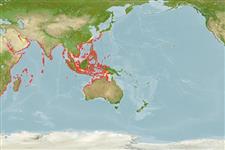>
Clupeiformes (Herrings) >
Engraulidae (Anchovies) > Engraulinae
Etymology: Encrasicholina: Greek, egkrasicholos, -os, -on = mixed with spleen.
More on author: Fowler.
Environment: milieu / climate zone / depth range / distribution range
Écologie
marin récifal; océanodrome (Ref. 51243); profondeur 5 - 35 m (Ref. 86942). Tropical; 42°N - 35°S, 30°E - 140°E (Ref. 189)
Indo-Pacific: Red Sea and Persian Gulf south to perhaps Durban in South Africa, Pakistan, India, Sri Lanka, and probably Burma. Also from southern Japan to China, Philippines, Thailand, Indonesia south to Brisbane, Australia, Japan eastward to Hawaii, the Solomon Islands, Fiji, Samoa and Tahiti.
Length at first maturity / Taille / Poids / Âge
Maturity: Lm ?, range 7 - ? cm
Max length : 13.0 cm TL mâle / non sexé; (Ref. 189)
Épines dorsales (Total) : 0; Rayons mous dorsaux (Total) : 12 - 15; Épines anales: 0; Rayons mous anaux: 14 - 17. Belly rounded with 3 to 6 sharp needle-like pre-pelvic scutes. Maxilla tip blunt, scarcely projecting beyond second supra-maxilla, not reaching to front border of pre-operculum. Isthmus short, preceded by small fleshy plate on urohyal between branchial membranes. Anal fin short, its origin behind base of last dorsal fin ray.
Epipelagic (Ref. 58302). A schooling species found inshore and in oceanic waters, hundreds of miles from land. Sometimes entering large atoll lagoons or deep, clear bays. Ranks among the most important food (bait) for tuna and other large pelagic fishes (Ref. 1602). Processed into nuoc-mam, a kind of fish pickle, in Indo-China (Ref. 4929).
Spawn in school (Ref. 205).
Whitehead, P.J.P., G.J. Nelson and T. Wongratana, 1988. FAO Species Catalogue. Vol. 7. Clupeoid fishes of the world (Suborder Clupeoidei). An annotated and illustrated catalogue of the herrings, sardines, pilchards, sprats, shads, anchovies and wolf-herrings. FAO Fish. Synop. 125(7/2):305-579. Rome: FAO. (Ref. 189)
Statut dans la liste rouge de l'IUCN (Ref. 130435: Version 2024-1)
Menace pour l'homme
Harmless
Utilisations par l'homme
Pêcheries: intérêt commercial mineur; appât: usually
Outils
Articles particuliers
Télécharger en XML
Sources Internet
Estimates based on models
Preferred temperature (Ref.
123201): 24.7 - 29.2, mean 28.3 °C (based on 928 cells).
Phylogenetic diversity index (Ref.
82804): PD
50 = 0.5039 [Uniqueness, from 0.5 = low to 2.0 = high].
Bayesian length-weight: a=0.00490 (0.00316 - 0.00759), b=3.26 (3.13 - 3.39), in cm total length, based on LWR estimates for this species & (Sub)family-body (Ref.
93245).
Niveau trophique (Ref.
69278): 3.4 ±0.45 se; based on food items.
Résilience (Ref.
120179): Haut, temps minimum de doublement de population inférieur à 15 mois (K=1.1-2.0).
Fishing Vulnerability (Ref.
59153): Low vulnerability (12 of 100).
Nutrients (Ref.
124155): Calcium = 124 [38, 413] mg/100g; Iron = 1.16 [0.41, 3.17] mg/100g; Protein = 20 [17, 22] %; Omega3 = 0.323 [0.144, 0.762] g/100g; Selenium = 37.7 [12.9, 120.3] μg/100g; VitaminA = 49.4 [9.8, 236.8] μg/100g; Zinc = 1.28 [0.70, 3.00] mg/100g (wet weight);
